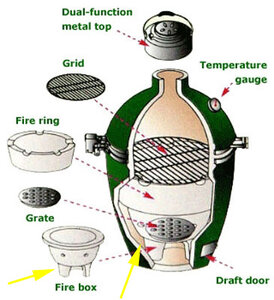- Dec 30, 2021
- 34
- 18
Hi there & greetings from drizzly Hertfordshire, UK. I've got a Large BGE and am trying to build up my repertoire and skillz. I have run a couple of low & slow cooks on it which have been very good (as well as pizza and a few roasts), but not without trouble. I'd love to get some advice from the pros on here and (hopefully) give something back in time...
The issue I currently have on a low & slow is that the temp shifts in ways I can't control. I'm measuring the grill temp with a probe (and meat temp too of course). I dial in what seems like a decent temp, and then leave it alone as best I can, but the grill temp does a few things over a 12-hour cook; yesterday I had the usual problems:
1. In the first 7 hours, the temp steadily & slowly declines (approx 5-10 degF /hour). It seems slow, but over a long period, that's a lot of lost heat. A very slight opening of the vents brings it up again, then a slight close to level the temp, but then it starts declining again...
2. Toward the end of the cook, the temp changed quickly & erratically despite me leaving it alone: a rise of 20 degF in 10 min, a 40 deg drop in 30 min an hour later. This was with minimal adjustment of vents.
3. Bizarrely, despite being in around 240 degF, the meat temp started dropping slightly in the last 30min of the cook (195 deg down to 194)
Was cooking on BGE charcoal, in light rain, conveggtor in place & feet up. Wrapped the meat in parchment to (successfully) break the stall at 150 degF.
The issue is that while the meat turned out brilliantly, the grill needed constant monitoring, especially at the end of the cook. I want to be in a position where I can leave it for hours at a steady temp, maybe overnight - and I'm not there yet..!
Any help gratefully received..!
marc
The issue I currently have on a low & slow is that the temp shifts in ways I can't control. I'm measuring the grill temp with a probe (and meat temp too of course). I dial in what seems like a decent temp, and then leave it alone as best I can, but the grill temp does a few things over a 12-hour cook; yesterday I had the usual problems:
1. In the first 7 hours, the temp steadily & slowly declines (approx 5-10 degF /hour). It seems slow, but over a long period, that's a lot of lost heat. A very slight opening of the vents brings it up again, then a slight close to level the temp, but then it starts declining again...
2. Toward the end of the cook, the temp changed quickly & erratically despite me leaving it alone: a rise of 20 degF in 10 min, a 40 deg drop in 30 min an hour later. This was with minimal adjustment of vents.
3. Bizarrely, despite being in around 240 degF, the meat temp started dropping slightly in the last 30min of the cook (195 deg down to 194)
Was cooking on BGE charcoal, in light rain, conveggtor in place & feet up. Wrapped the meat in parchment to (successfully) break the stall at 150 degF.
The issue is that while the meat turned out brilliantly, the grill needed constant monitoring, especially at the end of the cook. I want to be in a position where I can leave it for hours at a steady temp, maybe overnight - and I'm not there yet..!
Any help gratefully received..!
marc









